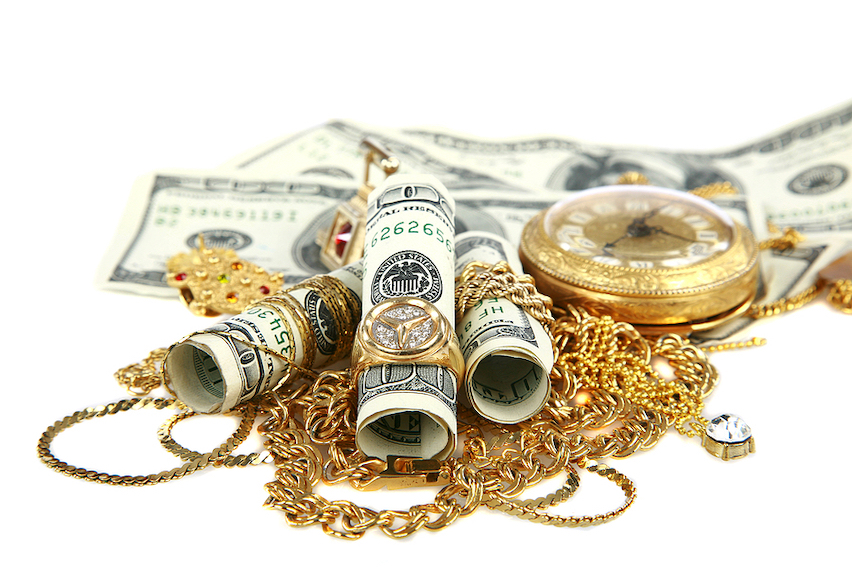 The popularity of gold jewelry and its connotation with value leads to a common question: If I want to invest in gold, is gold jewelry a good option? Unfortunately, there are some fundamental shortcomings of jewelry that make it a poor investment vehicle when compared with more reputable gold assets. Exploring the shortcomings of investing in gold jewelry as opposed to traditional gold investment products can lead to a properly diversified investment portfolio.
The popularity of gold jewelry and its connotation with value leads to a common question: If I want to invest in gold, is gold jewelry a good option? Unfortunately, there are some fundamental shortcomings of jewelry that make it a poor investment vehicle when compared with more reputable gold assets. Exploring the shortcomings of investing in gold jewelry as opposed to traditional gold investment products can lead to a properly diversified investment portfolio.
Why Gold Jewelry Is NOT Considered an Investment
1. Low purity
Gold purity, also known as fineness, is a crucial factor when determining the value of gold assets. Due to its characteristic softness, gold is typically alloyed with other metals to maintain shape and increase durability. However, the purity of gold jewelry is much lower than that of more traditional physical gold investment products like gold coins or gold bars. In general, the fineness of gold jewelry ranges from 0.375 to 0.917 with a lot of variability in between. Alternatively, most gold bars, bullion, and coins boast a fineness between 0.900 and 0.999. This significant disparity in purity means gold jewelry is broadly less valuable, making it a less attractive option for investors.
2. Low liquidity
High liquidity is characteristic of a worthwhile investment because it allows investors to convert the value of the asset into cash or another instrument when market conditions are advantageous. Unfortunately, gold jewelry can be considerably harder to sell than its bullion counterparts, further detracting from its investment quality. This lower liquidity is owed to the relatively limited size of the second-hand jewelry market and the subjective evaluation of jewelry pieces. Gold jewelry’s relatively low liquidity exposes investors to unnecessary risk, especially during economically volatile times.
3. Lack of international standards
The lack of international standards in the gold jewelry market makes it challenging for investors to accurately assess the purity, quality, and value of their gold jewelry holdings. In contrast, standard gold bullion, bars, and coins adhere to strict market norms in terms of fineness, sizes, and evaluations. This standardization creates a more robust, secure, and dependable market wherein investors can make smarter, more informed decisions. That’s partially why gold jewelry is at a higher risk for fraudulent activity. It’s much easier to produce counterfeit pieces in an industry without much oversight or regulation.
4. High premiums
Dealer premiums – the amount investors pay over the spot price of gold – are a perfectly normal part of the gold transactions. These premiums cover the overhead expenses of production, storage, and distribution assumed by gold dealers. In contrast to other precious metal assets, gold jewelry attracts exorbitant premiums due to additional costs such as appraisal, retail, or even brand name markups. This means you could easily pay more for the same amount of gold when investing in gold jewelry when compared to gold bullion.
5. Risk of misplacement
Gold jewelry is designed to be worn which greatly increases the risk of damage, theft, and loss. While it’s common practice for owners to lock up gold necklaces, rings, or earrings in a safe, these adornments are usually treated with less scrutiny and care than other gold instruments such as gold bullion or coins. Even when theft or loss is avoided, the inevitable wear and tear that comes with regular use can significantly diminish the value of jewelry. Your investments already face sufficient risk from standard market volatility; there’s no need to further expose your portfolio.
6. Not investment focused
Generally, gold jewelry isn’t considered an investment-focused asset. Although it can hold tremendous aesthetic and sentimental value, jewelry lacks many of the critical characteristics of a tried-and-true investment vehicle. This is reflected in the jewelry market which is primarily dominated by craftsmanship and cultural standards of beauty as opposed to the item’s inherent value. There are plenty of ways to invest in gold, but investors are generally better off sticking with reputable gold assets with a proven track record of maintaining value and hedging against inflation.
“When you’re buying…an investment, you want to make sure there’s a track record.”–Sr. Precious Metals Advisor Steve Rand
7. Ineligible for a gold IRA
Through a particular retirement account known as a gold IRA, investors can invest tax-advantaged dollars in physical gold. The government places strict limitations on the purity and types of gold instruments permitted in a gold IRA. Notably, the IRS doesn’t recognize jewelry as a legitimate gold asset, further harming its reputation as a viable investment vehicle. Jewelry tends to fall under the banner of collectibles which aren’t eligible for inclusion.
👉 Suggested Reading: IRA Eligible Coins for a Gold IRA
8. Unpredictable pricing
You don’t have to know how gold prices are determined to benefit from this popular metal’s inherent value. However, it is important to understand that the pricing of standard gold assets such as bullion, bars, or coins is fairly straightforward, standardized, and widely recognized. On the other hand, the value of gold jewelry is much more difficult to assess because of the subjective factors involved. This challenge of obscure pricing makes gold jewelry a poor investment choice for those who want an accurate idea of the value of their holdings.
Gold jewelry might have an attractive allure for fashion, but it falls short in nearly every assessment of a worthwhile investment vehicle. Fortunately, the landscape of gold investments is expansive, rich, and diverse, giving investors plenty of options from which to choose. If you’re interested in learning more about diversifying your portfolio with gold, download our FREE Precious Metals Investment Guide.


